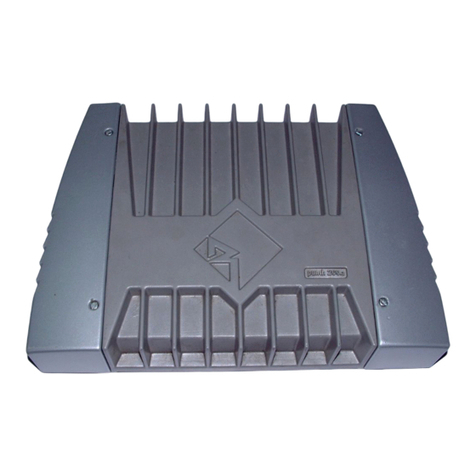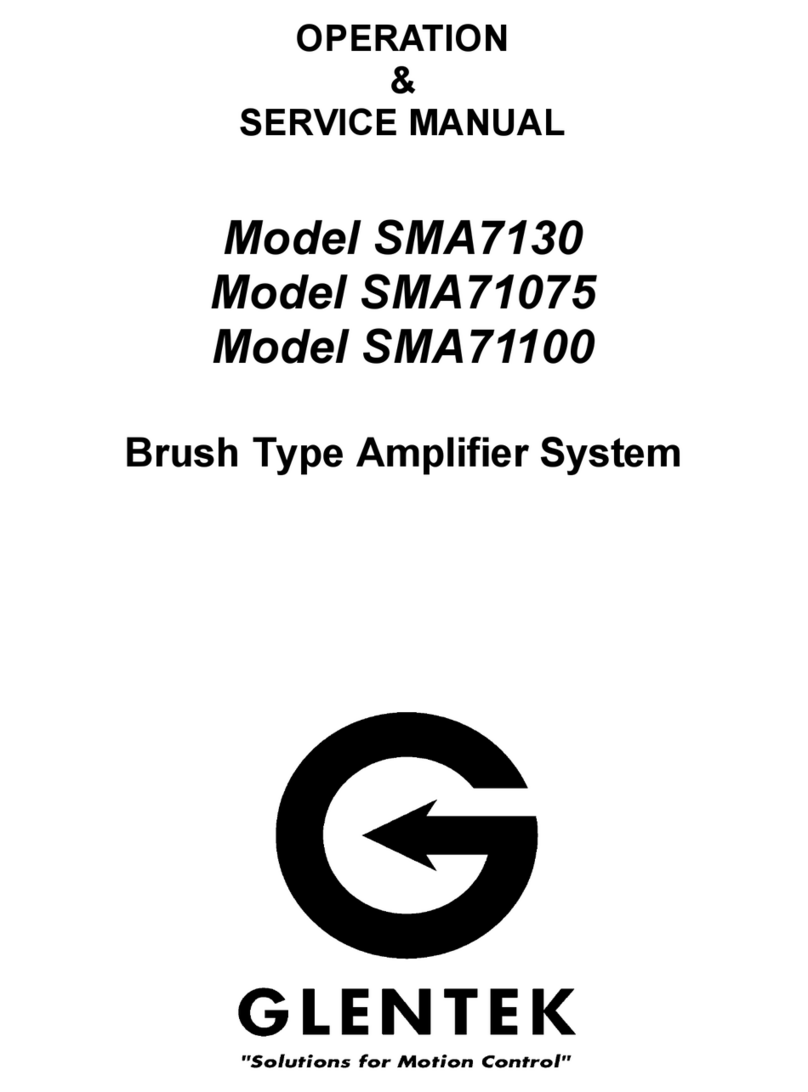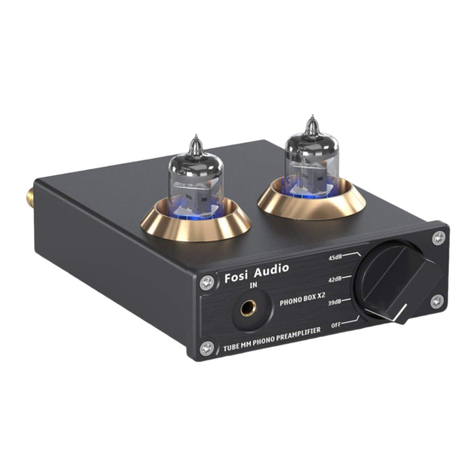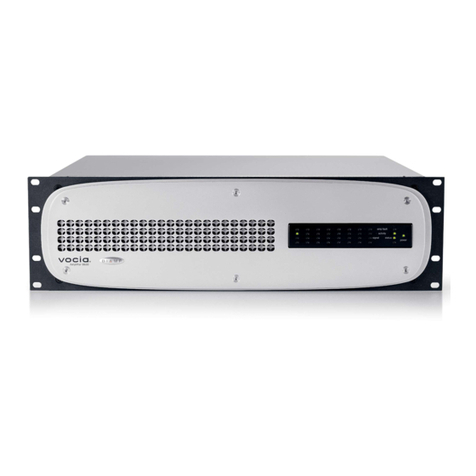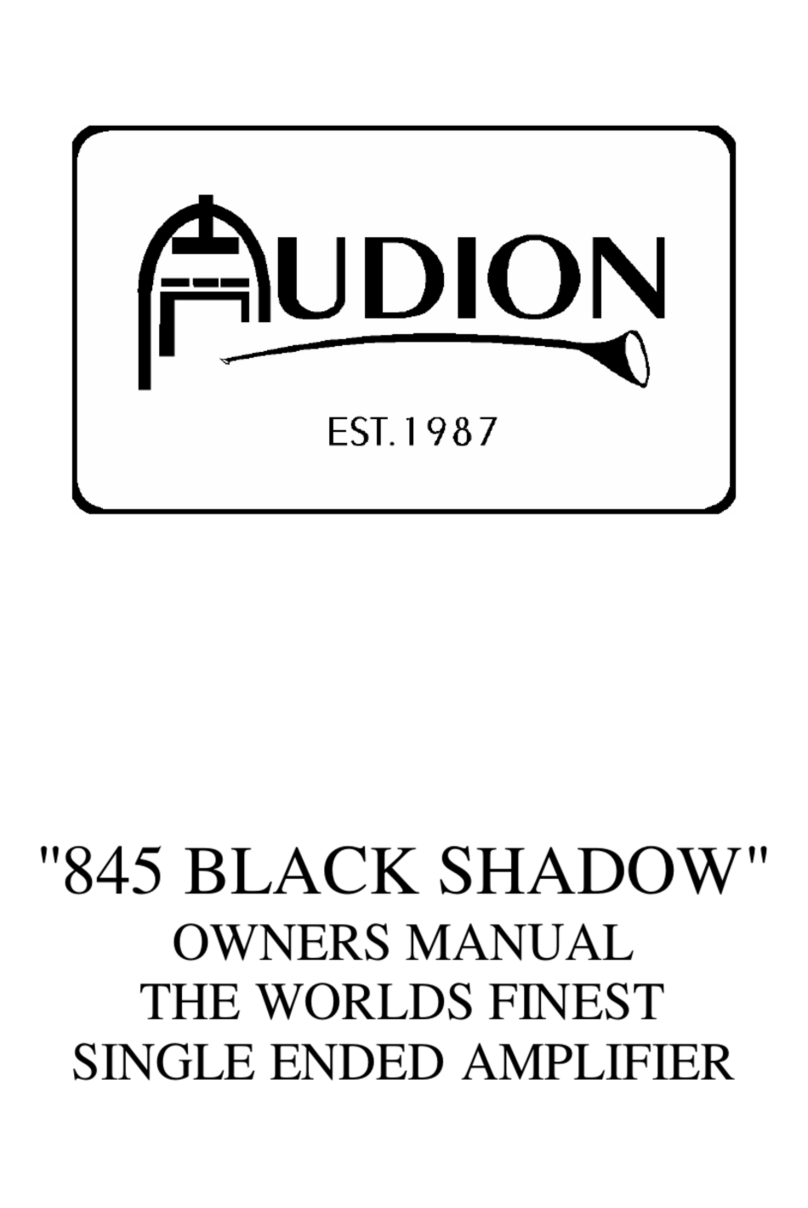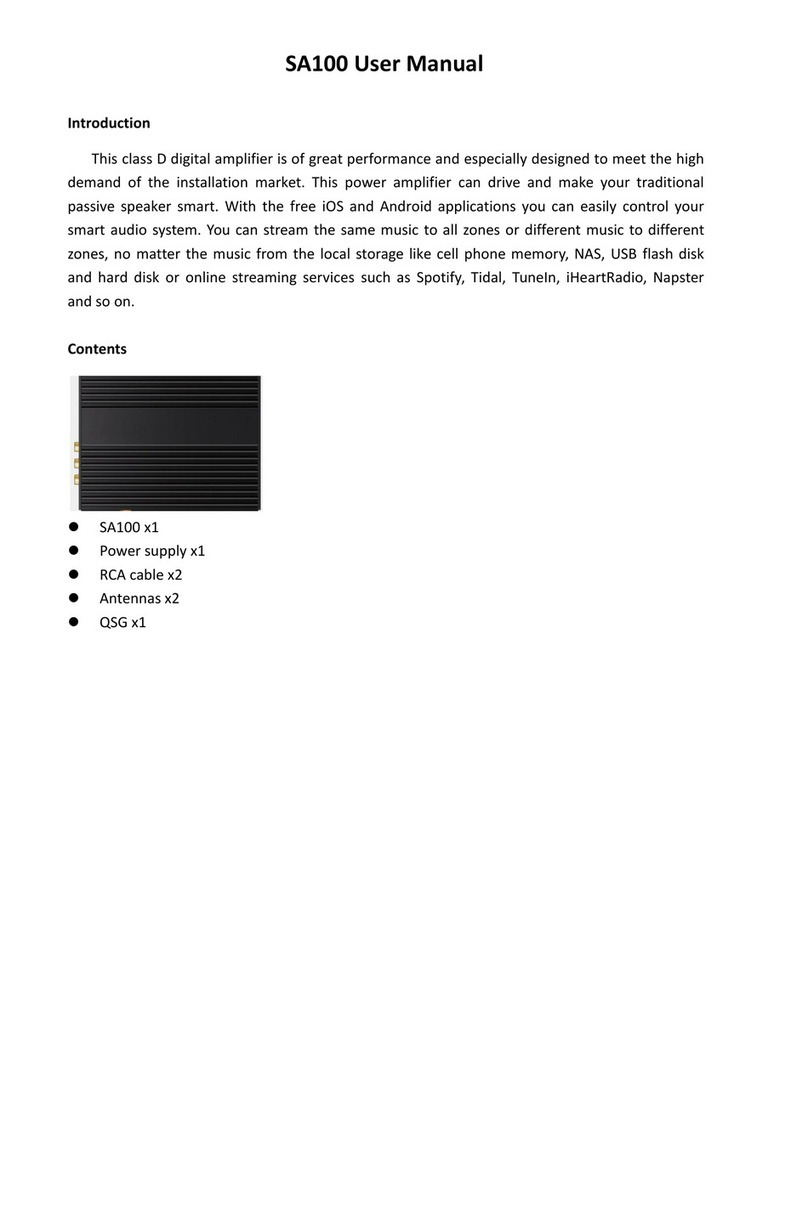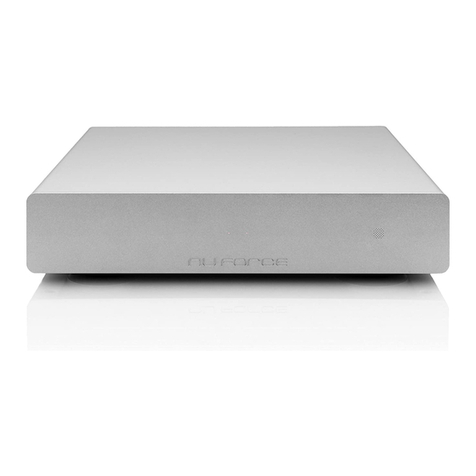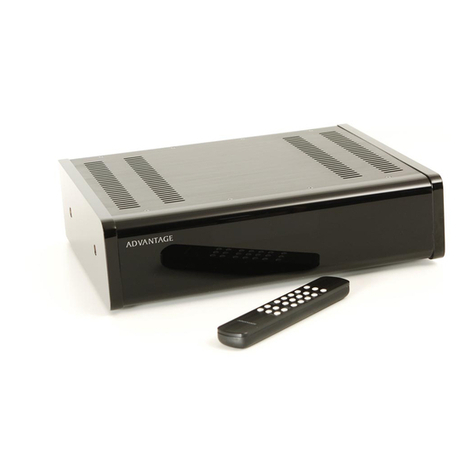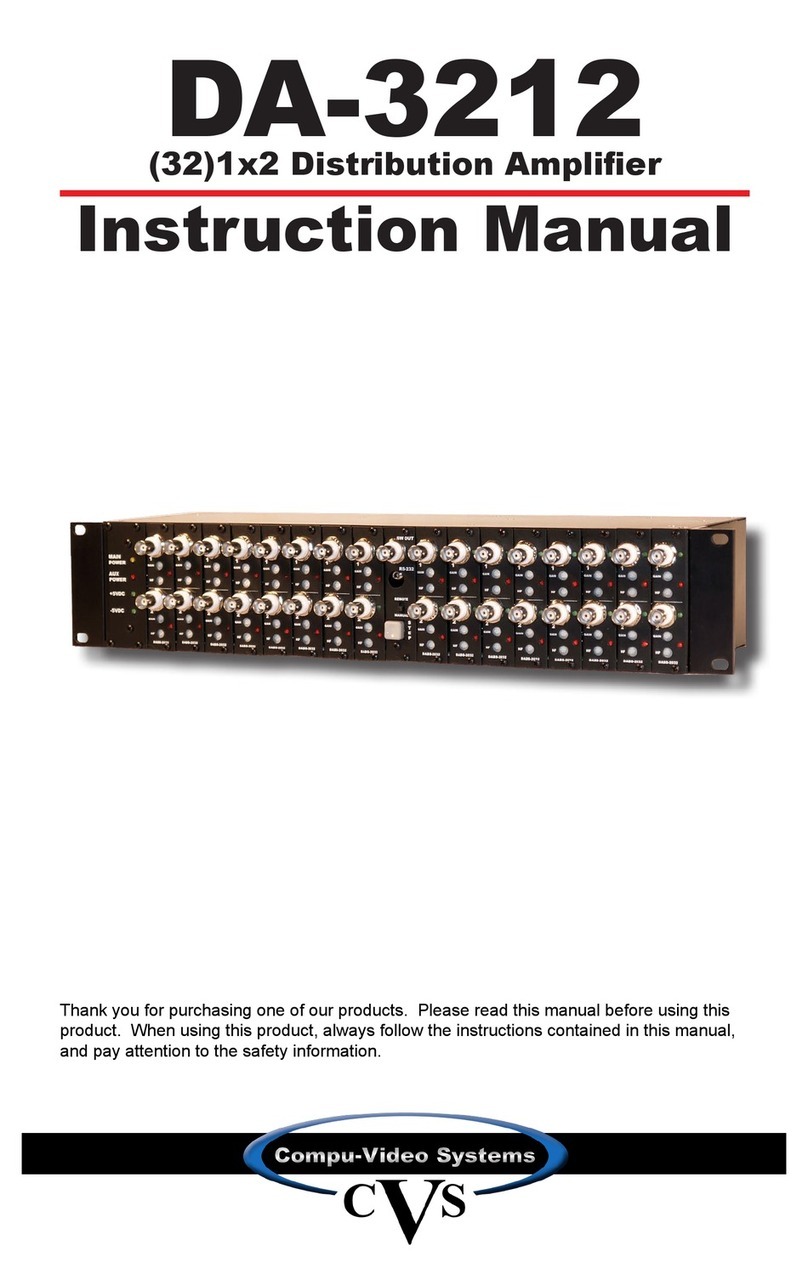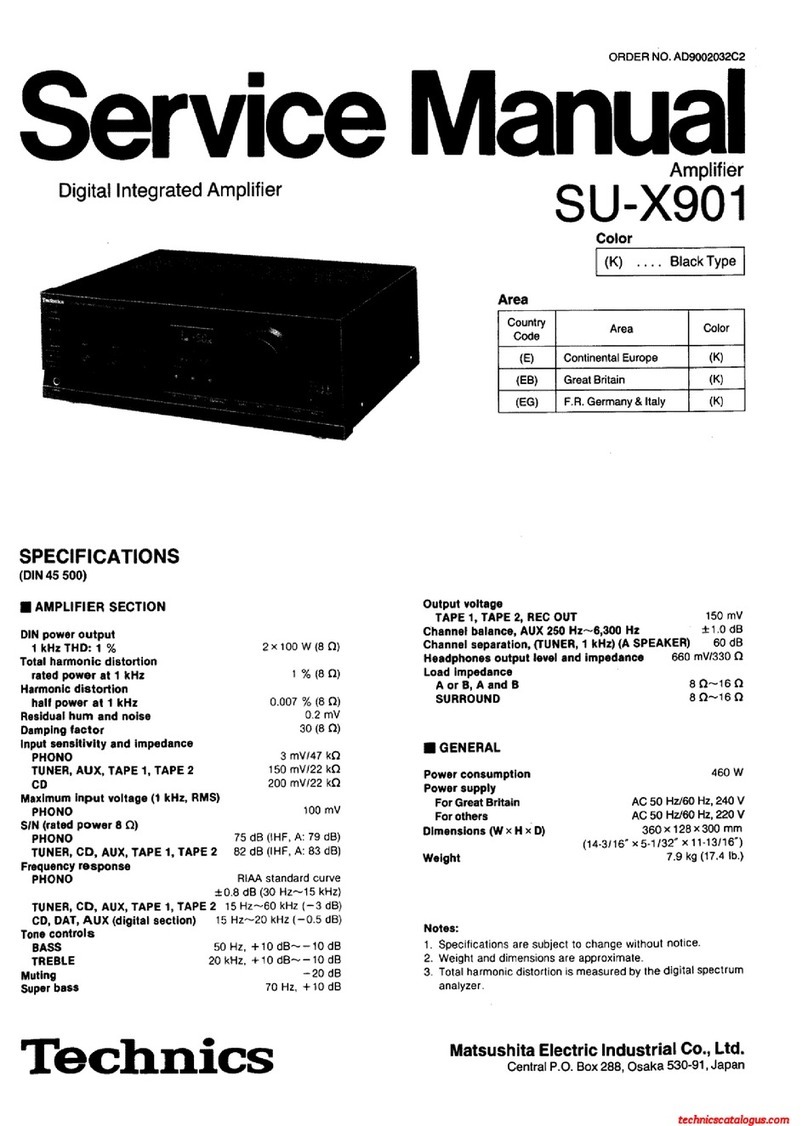Dishtronix DX2400L1 User manual

INSTRUCTION MANUAL
DX2400L1 HF LINEAR AMPLIFIER
“The Prometheus”
PATENT PENDING
DX2400L1INS1 Revision 1.0 10/2006
Dishtronix, Inc.
2497 ROAD 55
Bellefontaine, Ohio 43311 USA
TEL +1 937 292 7981
http://www.dishtronix.com
© 2006 by Dishtronix, Inc. All Rights Reserved.
Dishtronix

Dishtronix, Inc. Dx2400l1 instruction manual rev00.doc 06-10-18 5.14 Page 2/44
Printed in the United States of America
Copyright 2006 by Dishtronix, Inc.
ALL RIGHTS RESERVED
No part of this document may be copied, reproduced, transmitted or used without the
express written consent of Dishtronix, Inc.
Information, theory, techniques, processes, features and technology featured in this
manual may be covered by one or more pending U.S. patents.

Dishtronix, Inc. Dx2400l1 instruction manual rev00.doc 06-10-18 5.14 Page 3/44
______________________________________________________________________________
October 18, 2006
Dear Valued Customer,
Thank you for purchasing your new DX2400L1 Amplifier. It is my most sincere hope that you will be 100 percent
completely satisfied with your new amplifier.
This amplifier exists today because I could not purchase a solid state amplifier that was both legal limit and durable.
The Prometheus represents 7 long years of full time research and development which I have personally conducted
and supervised. The result is the first solid state amplifier commercially produced for the Amateur Service capable of
100% full duty cycle at the legal limit of 1500W.
Each circuit board inside this unit has been personally designed by me to be assembled in house at Dishtronix to give
you the ultimate service, performance, life, reliability and quality levels.
The Dishtronix mission is to be the innovation and quality leader in both the solid state high power market and in
customer satisfaction. Dishtronix was first to demonstrate continuous key 1500W CW the entire weekend of the
2004 and 2005 Dayton Hamvention. Your purchase and support insures that Dishtronix will be able to continue its
pioneering efforts in the HF solid state high power arena.
I know there are some other solid state units coming along. Please set my unit side by side with theirs and transmit
1500W into the dummy load with a brick on the key. Which unit appears to you to be purposely over designed? If
your life depended on having an amplifier, which one would you prefer? If you need more persuasion, twist the
drive knob to the right!
Dishtronix products are not the least expensive because I do not ever cut corners off of lifetime or performance just
to save a few dollars. In fact, I use the best components that I can buy without regard to cost. If good enough
components don’t exist I make them or have them made. I know that you, my valued customer, expect more, which
is why I can personally stand behind every DX2400L1 amplifier that I sell and why I am proud to put my name on
my company. The DX2400L1 is built simply to be the best.
If you have any problems with this unit, please do not hesitate to contact me directly. If there is anything I can do to
make your Dishtronix amplifier experience more positive, please let me know.
Thank you again for your valued business.
Sincerely,
Steven M. (Mike) Dishop, N8WFF
President, Dishtronix, Inc.
“Dishtronix Solid Power ™ Anywhere, Anytime, Anyplace”.
MADE IN USA
PATENTS PENDING
Designed and Manufactured in the United States of America by a 100% American owned
company.
Dishtronix

Dishtronix, Inc. Dx2400l1 instruction manual rev00.doc 06-10-18 5.14 Page 4/44
TABLE OF CONTENTS
1. INTRODUCTION...................................................................................................................7
1.1 DX2400L1 RF Deck Features..........................................................................................8
1.2 SPECIFICATIONS: DX2400L1 HF LINEAR AMPLIFIER .........................................9
1.3 Supplied Accessories......................................................................................................10
1.4 Available Accessories ....................................................................................................10
2. INSTALLATION...............................................................................................................11
2.1 Installation Precautions ..................................................................................................12
2.2 Unpacking ......................................................................................................................13
2.3 HV DC Supply Verification ...........................................................................................13
2.4 Mounting RF Deck on Top of Power Supply.................................................................14
2.5 Full Break In QSK..........................................................................................................14
2.6 Semiautomatic Break In .................................................................................................14
2.7 PTT QSK Operation.......................................................................................................15
3. OPERATION .........................................................................................................................19
3.1 Front Panel Controls.......................................................................................................21
3.2 Rear Panel Controls and Connectors..............................................................................22
3.3 Connector Pin Definitions..............................................................................................25
3.4 +12V IN Jack..................................................................................................................26
3.5 Auto Power On Feature..................................................................................................26
3.6 Programming Mode........................................................................................................26
3.7 Band Selection................................................................................................................27
3.7.1 Automatic Band Selection (Default) ......................................................................27
3.7.2 Manual Band Selection ..........................................................................................27
3.7.3 Band Selection with Internal Frequency Counter ..................................................27
3.8 Band Data Hardware Interface .......................................................................................28
3.9 ALC ................................................................................................................................28
3.9.1 ALC Indicator.........................................................................................................29
3.9.2 ALC-SWR Foldback ..............................................................................................29
3.9.3 ALC Adjustment Procedure ...................................................................................29
3.9.4 ALC Irregularities ..................................................................................................30
3.10 Protection Features.........................................................................................................30

Dishtronix, Inc. Dx2400l1 instruction manual rev00.doc 06-10-18 5.14 Page 5/44
3.10.1 SWR Protection......................................................................................................31
3.10.2 Overdrive Protection .............................................................................................31
3.10.3 Over Current Protection .........................................................................................31
3.10.4 Power Supply Over Voltage Protection .................................................................31
3.10.5 Power Supply Under Voltage Lockout ..................................................................32
3.10.6 Over Temperature Protection .................................................................................32
3.10.7 Combiner Failure Fault ..........................................................................................32
3.10.8 T/R Failure Fault ....................................................................................................32
3.10.9 Error Status Display ..............................................................................................32
3.10.10 Clearing Fault Conditions ..................................................................................33
3.11 Remote Interface ............................................................................................................34
3.11.01 Interface Termination Resistors .........................................................................34
3.11.02 Interface Line Bias .............................................................................................35
3.11.03 Setting Remote Interface Power Options ...........................................................35
4. THEORY OF OPERATION ..............................................................................................37
4.1 Block Diagram ...............................................................................................................39
4.2 Amplifier Circuitry Overview........................................................................................39
5.0 SERVICE ...........................................................................................................................41
5.1 Maintenance ...................................................................................................................42
5.1.1 Optional Rear Fan Filters .......................................................................................42
5.1.2 External Appearance and Care...............................................................................42
5.1.3 Fan Replacement ....................................................................................................42
5.2 Factory Service...............................................................................................................43
NOTES ...........................................................................................................................................44
TABLE OF FIGURES
Figure 1. DX2400 Typical Installation with QSK Full Loop Keying......................................16
Figure 2. Typical Installation for Non-QSK Keying (Vintage) Transceiver..........................17
Figure 3. QSK Installation using Non-QSK Transceiver and External Keyer ....................18
Figure 4. Front Panel Features ................................................................................................20
Figure 5. Rear Panel Controls and Connectors......................................................................24
Figure 6. Connector Pin Definitions..........................................................................................24
Figure 7. DX2400L1 Block Diagram.........................................................................................38

Dishtronix, Inc. Dx2400l1 instruction manual rev00.doc 06-10-18 5.14 Page 6/44
This page left intentionally blank.

Dishtronix, Inc. Dx2400l1 instruction manual rev00.doc 06-10-18 5.14 Page 7/44
1. INTRODUCTION
About the name……
According to Greek mythology, Prometheus gave fire to man.
In retaliation, Zeus (the King of the Gods) chained him to a rock where every day
an eagle ate his liver, and each night it magically grew back.
Three thousand years later, this Prometheus puts legal limit fire in the wire, and
sports a battery of technological features to prevent it’s guts from being blown out!
No Compromise HF Performance from Dishtronix.

Dishtronix, Inc. Dx2400l1 instruction manual rev00.doc 06-10-18 5.14 Page 8/44
1.1 DX2400L1 RF Deck Features
The DX2400L1 RF Amplifier incorporates a number of innovative and useful features:
•Fully Automatic Band Switching: The DX-2400L1can be controlled (optional converter
may be required) with the transceivers band data through CAT style optically isolated
interface.
•For older transceivers without band data, the DX-2400L can sample the incoming RF
drive and determine the proper band of operation under microprocessor supervision.
•Four Position Antenna Switch with automatic memory for last antenna used for each
band.
•Optically Isolated RS422 / RS485 remote interface allows operation up to 1500 feet away
through one or two twisted cable pair with optional PC adapter and software package or
optional remote control head.
•Optically isolated remote on capability from transceiver +12V Auxiliary jack.
•ALC: Negative going from 0 to negative 10 Volts, adjustable. SWR-ALC foldback
protection.
•SWR overprotection circuit. Over temperature warning and shutdown protection. Over
/under voltage lockout protection. Overdrive protection. Hardware failure protection
(combiner balance, PIN T/R failure)
•Digital bargraph for Forward Power, Reflected Power and True (computed) SWR.
•PTT or selectable Full Loop QSK Keying to interlock transceiver and amplifier.
•Vacuum antenna relay as standard equipment. PIN diode T/R switch available as an
option.
•FLASH Microprocessor allows field upgrades of amplifier firmware.
•Separate low voltage control transformer for bias and microprocessor circuits reduces
power consumption in continuous standby mode and allows metering of transceiver when
in bypass mode.
•Full optic isolation of all control functions (Key In, Key Out, PTT, Band Data, Remote
On) from transceiver as well as full optic isolation of computer /remote interface port.
•2400W PEP total dissipation rating of RF power transistors means conservative design
with plenty of headroom
•Low Pass Filters constructed with 12 gage coils and custom high power capacitors.
•Oversize (30 lb) heat exchanger and 4 thermostatically controlled, ball bearing, variable
speed cooling fans mounted in push – pull configuration for redundancy.

Dishtronix, Inc. Dx2400l1 instruction manual rev00.doc 06-10-18 5.14 Page 9/44
1.2 SPECIFICATIONS: DX2400L1 HF LINEAR AMPLIFIER
Frequency: All amateur bands 160 – 15 meters,
12 / 10 meters with license modification.*
Power Output: 1500W PEP (SSB), 1500W (CW/FM)
375W Carrier (AM), minimum.
Duty Cycle: 100% Continuous Duty at 1:1 SWR.
Derate above 25° C ambient temperature.
Input Power 50W nominal
Input SWR: Less than 1.5:1.
Bypass SWR: Less than 1.5:1.
Output SWR: 2:1 Maximum.
3rd Order IMD: More than 30 dB below PEP.
Harmonic Suppression: More than 46 dB below carrier.
Power Sensor Accuracy: ± 5% of Full Scale.
Input Voltage: 230 ±10 VAC, 50 / 60 Hz, 5 KVA (LPS4800)
180-264 VAC 50/60 HZ 14 KVA (SPS4800)
Dimensions:
DX2400L1 RF Deck 10.5 H x 17* W x 22** D inches.
LPS4800 Linear Supply 7 H x 17* W x 22** D inches.
SPS4800 Switching Supply 5.25 H x 17* W x 22** D inches.
* 19 inches wide with rack mount option.
**24 inches deep with rack mount handles.
Weight: DX2400L1 RF Deck 55 lbs.
LPS4800 Linear Supply 120 lbs.
SPS4800 Switching Supply 54 lbs.
*Requires purchase of modification kit and valid amateur license.

Dishtronix, Inc. Dx2400l1 instruction manual rev00.doc 06-10-18 5.14 Page 10/44
1.3 Supplied Accessories
The following accessories are supplied with the DX2400L1 RF Amplifier:
•LPS4800 Linear Power Supply or SPS4800 Switching Power Supply.
•2 High Voltage Supply Interconnect cables.
•4 small dowel pins to stack RF deck to Power supply.
•Manuals.
1.4 Available Accessories
The following accessories have been specifically designed by Dishtronix to work with the
DX2400L1 RF Amplifier:
•Dishtronix Amplifier to RS232 Computer Interface.
•Dishtronix Fan Filter Kit.
•Dishtronix DX2400L1 Amplifier to Yaesu Band Data Cable.
•Dishtronix DX2400L1 Amplifier to Icom Band Data Converter and Cable.
•Dishtronix DX2400L1 Amplifier to Ten-Tec Band Data Cable.
•Dishtronix DX2400L1 Amplifier to Kenwood Serial Port Band Data Converter and Cable.
•Dishtronix 1:1 3KW Current Balun.
•Dishtronix DWM-2104A 2KW HF/6m Active Variable Peak Hold Cross Needle
Wattmeter (Patent Pending).
•Dishtronix Remote Control Head (in progress).

Dishtronix, Inc. Dx2400l1 instruction manual rev00.doc 06-10-18 5.14 Page 11/44
2. INSTALLATION

Dishtronix, Inc. Dx2400l1 instruction manual rev00.doc 06-10-18 5.14 Page 12/44
2.1 Installation Precautions
The DX2400 amplifier is capable of in excess of 1500W sustained operation. Several precautions
need to be taken to insure the rest of your installation is capable of handling high power levels.
•Station AC Power Supply: Recommend 10 gage wiring and 30A circuit with NEMA
outlet installed in accordance with the National Electric Code and all local ordinances and
zoning regulations. Consult a qualified electrician if you have any questions.
•Make certain your antenna installation can handle at least 3KW of peak power if
sustained 1500W operation such as FM or 375W carrier AM is planned. Dishtronix
manufactures conservatively designed high power baluns. Use a high quality, low loss
coax such as RG-8X, etc. Antenna wire should not be smaller than #12 AWG copper.
•Station Grounding: Equipment must be grounded properly. The installation diagrams
show the ground system used at Dishtronix. Each piece of equipment must be bonded
individually to the ground and not daisy chained. The ground straps may be fabricated
from the flattened braid of RG-8X coax, or may be copper strap. Braids are fastened with
a clamp to a 1” OD piece of copper plumbing pipe that runs behind the operating position
desk. The braids may also be soldered to the pipe. This intermediary ground is then
strapped to the external station ground rods by more braids. Two inch slit copper rolls are
available through various sources that can be used in place of the braid. Consult the
ARRL Radio Amateurs Handbook and the National Electric Code Handbook for
information on ground systems and high power installations.
•RF exposure. It is your responsibility as the station licensee to ensure that your
installation meets specified RF safety levels. Consult with CFR Title 47, Part 97 of the
Federal Code of Regulations and the latest edition of the ARRL Radio Amateurs
Handbook for more information.
•Station Operating Position: Warning, the DX2400 Amplifier and LPS4800 linear supply
is heavy, approaching 200 lbs. Ensure that your table or rack is sturdy and can safely
handle the weight before installation.
•CAUTION! The DX2400L1 is designed for operation ONLY with the LPS4800 Linear
Power Supply, or the SPS4800 Switching Power Supply! The finals of the DX2400
operate at 72 Volts and require peak currents approaching 80 Amperes.
•DO NOT ATTEMPT TO OPERATE THIS AMPLIFIER FROM A 12 VOLT
(MOBILE) POWER SUPPLY!
•DO NOT OPERATE THIS AMPLIFIER FROM ANY SUPPLY OTHER THAN
THE APPROVED DISHTRONIX POWER SUPPLY. Use of an unauthorized power
supply voids the warranty.
•DO NOT OBSTRUCT THE VENT OR FAN OPENINGS! Cooling air is vital to the
proper life and operation of this amplifier. Remember when transmitting at 1500W that
you need to remove approximately 1500W of heat from the cabinet!
•CAUTION! If you are using a high power transceiver with more than 100W of RF
output you may need to activate the internal 3dB attenuator. See Section 3.6 and 3.10.2.
OVERDRIVING YOUR AMPLIFIER MAY VOID YOUR WARRANTY!

Dishtronix, Inc. Dx2400l1 instruction manual rev00.doc 06-10-18 5.14 Page 13/44
2.2 Unpacking
First refer to the Power Supply manual for installation and set up of your power supply if you
have not already done so.
Carefully uncrate the DX2400L1 Amplifier RF deck. Save the packing for future use should it be
required. Two identical 8 pin HV DC Power Cables, a 6 pin Control Interconnect Cable and four
small dowel pins should be included in the package.
2.3 HV DC Supply Verification
After installing your AC power plug on the AC supply cable according to the instructions in the
power supply manual, the DC supply voltage should be checked.
1. Connect the amplifier deck and power supply together with the 6 pin control cable. Do
not connect the 8 pin HV DC cables at this time.
2. The RF amplifier front panel power switch should be in the OFF position.
3. Connect the AC power line to the AC mains supply.
4. Connect a voltmeter across the HV supply pins.* (Refer to power supply manual)
5. Turn the front panel switch on. The amplifier front panel lights should come on.
6. Press the front panel BYPASS switch to activate the contactor in the LPS/SPS4800 Power
Supply. A loud click should be heard.
7. After allowing 30 seconds for the voltage to stabilize, the supply voltage should measure
between 70 - 80 volts on the voltmeter. Record the supply voltage here: __________.
8. Switch the amplifier front panel power switch off.
9. Remove the Control Interconnect Cable.
10. Unplug the power supply from the AC mains.
If the DC supply voltage is significantly high or low, the line voltage tap inside the LPS4800 may
need set to a lower position or the internal voltage adjustments on the SPS4800 may need reset. .
Refer to the appropriate Power Supply manual for more details.
*Note that if using the SPS4800 Switching Power Supply that each pin of the HVDC connector
needs to be checked. Consult the SPS4800 Switching Power Supply for more information.

Dishtronix, Inc. Dx2400l1 instruction manual rev00.doc 06-10-18 5.14 Page 14/44
2.4 Mounting RF Deck on Top of Power Supply
The RF deck may be mounted on top of the Power Supply if desired. There are two small dowel
pins included in the package. Fit two of these pins into the top center hole of two of the four
metal feet mounted on top of the power supply. It is best to place one pin diagonally from the
other. Next, with a helper, lift the RF deck and place carefully over the power supply, guiding
the feet of the RF deck over the pins so that the RF deck drops into place and will not slide off of
the power supply. Now you may attach the two HV DC power cables, the control interconnect
cable, the ground straps and other interconnecting lines to the exciter such as ALC, PTT, etc.
Refer to the following discussion of Loop Keying and Break In Operation to determine correct
installation for your particular transceiver.
2.5 Full Break In QSK
{Operation with Modern Transceivers that use Full Loop Keying}
Some modern transceivers feature full loop keying circuitry. The idea behind full loop keying is
to correctly sequence the external power amplifier so that it is switched in line BEFORE the
transmitter is keyed, and remains in line a short time AFTER the transmitter is unkeyed.
Figure 1 shows correct installation with a full loop keying transceiver. With this type of
installation there is no separate PTT line to the amplifier, so the amplifier front panel QSK key
control should always be activated regardless of the exciter mode. The transceiver signals the
amplifier to place itself in transmit mode through the exciter’s KEY OUT line which is connected
to the amplifier KEY IN connector. When the amplifier is placed in QSK mode, whenever the
transceiver pulls this line to ground the amplifier will activate its internal antenna changeover
relays. When the amplifier is ready to transmit, it will signal the exciter to produce RF by pulling
the amplifier KEY OUT line to ground. This line is connected to the exciter KEY IN line. When
the key is released, the exciter should quit producing RF and release the exciter KEY IN line.
After a brief pause to insure no RF is flowing, the amplifier changes back to receive mode.
2.6 Semiautomatic Break In
{Operation with Traditional Transceivers using PTT (not Full Loop) Keying}
It is possible to operate the exciter in a more traditional mode of operation where the transceiver
simply activates the amplifier change over relay. Figure 2 details installation of the amplifier
with vintage or non-QSK transceivers. For this installation the exciter PTT OUT line simply
connects to the amplifier PTT IN jack. The front panel QSK operation must be deactivated.
When the transmitter is keyed, it signals the amplifier to come on line by pulling the PTT line to
ground. The amplifier switched the antenna to the antenna output first to insure that the amplifier
will not operate into an open circuit or hot switch the output relay. Once the antenna relay is
activated, the amplifier switches the exciter output to the amplifier input. When the PTT line is
released, the amplifier input relay is released, and then the amplifier antenna relay is released.

Dishtronix, Inc. Dx2400l1 instruction manual rev00.doc 06-10-18 5.14 Page 15/44
2.7 PTT QSK Operation
{QSK operation with Transceivers WITHOUT Full Loop Keying}
It is possible to run QSK style operation with the amplifier using a non QSK or vintage exciter.
Figure 3 details this installation.
For QSK operation connect the external straight key (or external electronic keyer – Do not use
the keyer inside the exciter!) directly to the amplifier KEY IN connector. Connect the amplifier
KEY OUT line directly to the exciters CW KEY INPUT. Note that the exciter PTT out line must
be connected to the amplifier PTT IN line. When using non QSK operation such as semi break in
CW, SSB, AM, or FM modes, deactivate the amplifier front panel QSK mode and T/R operation
will be as described in the SEMI AUTOMATIC BREAKIN paragraph above. When CW
operation is desired, activate the front panel QSK mode. When the key is activated, the amplifier
will sequence the T/R relays to the transmit position. The amplifier internal circuitry will delay
the CW keying pulse a short period until the T/R relays are ready, and then pass the pulse to the
amplifier KEY OUT line. Since this line is connected to the exciter CW KEY jack, the exciter
will go into transmit immediately and the amplifier will be ready. When the key is released, the
amplifier KEY OUT line is immediately released allowing the exciter to return to receive mode.
The amplifier relays are held in the transmit position for a short time until RF quits flowing and
then are released to the receive position.

Dishtronix, Inc. Dx2400l1 instruction manual rev00.doc 06-10-18 5.14 Page 16/44
Figure 1. DX2400 Typical Installation with QSK Full Loop Keying

Dishtronix, Inc. Dx2400l1 instruction manual rev00.doc 06-10-18 5.14 Page 17/44
Figure 2. Typical Installation for Non-QSK Keying (Vintage) Transceiver

Dishtronix, Inc. Dx2400l1 instruction manual rev00.doc 06-10-18 5.14 Page 18/44
Figure 3. QSK Installation using Non-QSK Transceiver and External Keyer

Dishtronix, Inc. Dx2400l1 instruction manual rev00.doc 06-10-18 5.14 Page 19/44
3. OPERATION

Dishtronix, Inc. Dx2400l1 instruction manual rev00.doc 06-10-18 5.14 Page 20/44
Figure 4. Front Panel Features
Table of contents

